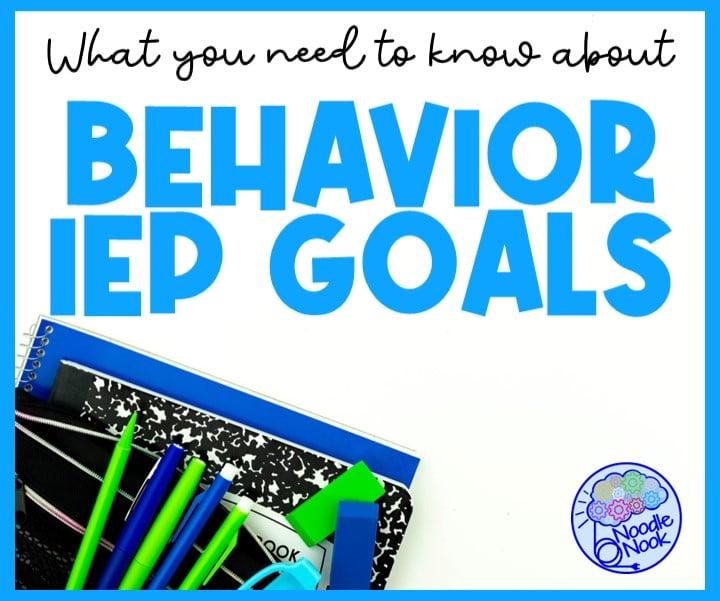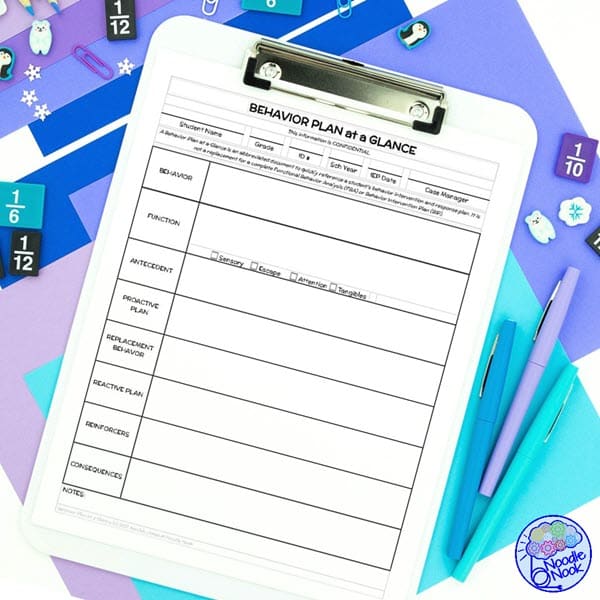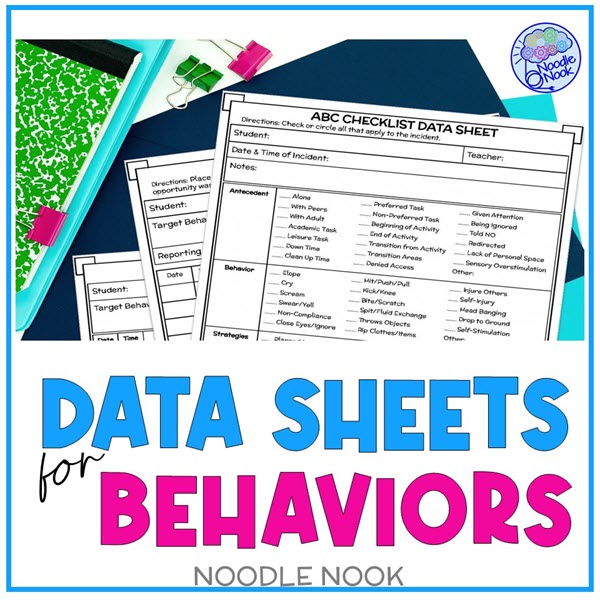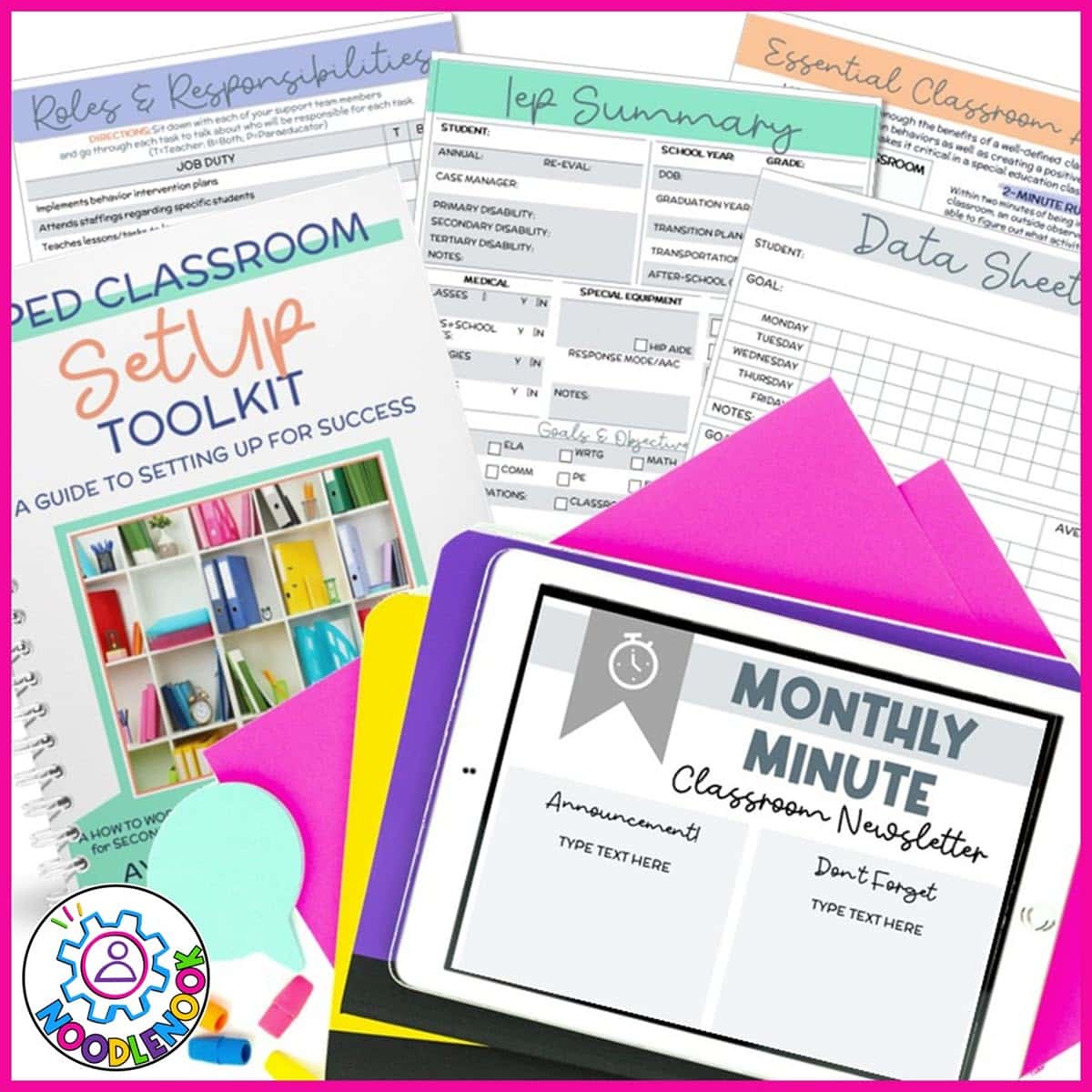When you’re in the classroom dealing with behaviors ranging from mild irritations to full on catastrophes, you KNOW you have to address the behavior and that means it’s time to dive into behavior IEP goals.
What is a Behavior IEP?
Most special education teachers know exactly what an IEP is. It’s an Individualized Educational Plan. A Behavior IEP is a little different. It focuses on specific goals related to a target behavior that is inhibiting a student’s access to the general education setting and curriculum, to non-disabled peers, or limits their quality of life.
Essentially, a behavior IEP is a document that outlines specific goals and strategies for addressing behaviors that are impacting a student’s ability to succeed in school. It’s a best practice when you find yourself working with students who have disabilities that approaches behavior in a more positive manner. Having a behavior plan allows everyone on a team to address a student’s behavior with a consistent approach.
And, because the behavior plan is customized to a student, the approaches to addressing problem behaviors allow for a higher rate of success and make it easier to address undesired behavior in targeted school settings. By setting specific and measurable goals and then collecting data on progress, teachers can track the effectiveness of their strategies and make adjustments as needed.
What Should Be in a Behavior Plan?
A behavior plan is a document that outlines specific strategies for addressing problem behaviors in a student and drives related behavioral goals. That means the plan has to be pretty specific and cover a lot of information to actually be relevant and effective. It starts with having some specific behavior goals that address the most pressing behavior first. Don’t write a plan that tries to address ALL a student’s behavior issues at the same time.
It won’t work.
When developing a behavior plan, be sure to identify and include the following elements:
- The target behavior: This is the specific behavior that the student is expected to work on and improve. The target behavior should be clearly defined and measurable, so that progress can be tracked and evaluated.
- The function of the behavior: Understanding the function or purpose of a student’s problem behavior is key to developing effective interventions. Different behaviors may serve different functions, such as attention-seeking, avoidance of a task, or escape from a difficult situation.
- The antecedent to the behavior: The antecedent is the event or situation that precedes the behavior. Identifying the antecedent can help educators understand what triggers the behavior and develop strategies to prevent it from occurring.
- Proactive strategies: These are strategies that can be implemented to prevent the problem behavior from occurring. Proactive strategies might include modifying the environment, teaching appropriate coping skills, or reinforcing alternative behaviors.
- Replacement behavior: A replacement behavior is an alternative behavior that the student can use instead of the problem behavior. Teaching a replacement behavior can help the student learn more appropriate ways of coping with difficult situations.
- Reactive plan: A reactive plan outlines the specific steps that will be taken in response to the problem behavior if it does occur. This might include using prompts to remind the student of appropriate behaviors, providing consequences, or using other interventions to address the behavior.
- Preferred reinforcers: Reinforcers are things that increase the likelihood of a behavior occurring. Identifying the student’s preferred reinforcers can help educators use reinforcement effectively to promote positive behavior.
- Consequences: Consequences are the results or outcomes of a behavior. Both positive and negative consequences can be used to shape behavior, depending on the desired outcome. It’s important to consider both the short-term and long-term consequences of a behavior when developing a behavior plan.
Setting Specific IEP Goals
Setting specific behavior goals is an important element of a behavior IEP. These goals should be clear and measurable, so that progress can be tracked and evaluated. When it comes to setting specific IEP goals, an IEP team or case manager should start with examining some baseline data to target the behavior that’s most critical or causing the most disruptions.
The goal should focus in on the specific ways a student is having a hard time, like with managing an undesired task or task avoidance, with social interactions and encroaching on other people’s personal space, or maybe with completing an assigned task or managing their behavior in stressful situations.
Two Important Measurements
As you sit down to write a meaningful IEP goal for a student to target an undesired behavior, there are a variety of ways to address that. What’s most important, though, is to make sure the goal can pass two important tests; the dead man’s test and the stranger test.
The dead man’s test is to look at the behavior IEP goal and decide if a student could master it if they were dead. In other words, by doing nothing, can they achieve mastery. An example of that is a goal like this: “When given work demands, the student will refrain from hitting with 100% accuracy”.
This is a horrible goal!
If a student didn’t do anything, like if they were dead, they could master the goal. Some of the most common behavior IEP goals do nothing to address the use of any appropriate coping strategies or the use of self-monitoring to improve the behavior. Any goal that says ‘refrain from’ is probably not up to snuff.
The stranger test is a way to ensure that you’ve written a clear and concise goal. This is a way of saying that if a stranger came into the room, they could identify the target behavior and the replacement behavior based on the way the goal was written.
“When presented with work demands, Student will use coping strategies (deep breathing, positive self-talk, movement breaks, etc.) to complete the task in 80% of opportunities.”
This kind of goal is easy to identify by anyone who is working with the student because it states with specificity the condition, which is being presented with work demands, and the strategies a student will use to get to work completion. By writing these specific behavior IEP goals, it makes it easier for us to do our data collection and also know the strategies we need to teach a student as part of their education program.
Strategies To Use with Behavior Goals
When you are dealing with impulsive behavior, withdrawn behavior, or unexpected behavior from a student, you need a consistent way to deal with it. But that is your reactive plan. That’s what you’re doing AFTER the behavior happens. We need solutions for BEFORE the behavior. That’s where a specific coping strategy or collection of strategies can support a student to help them manage behaviors. And hopefully, this is before they ever occur. Some ideas for strategies are:
- Classroom rules: Clearly outlining and consistently enforcing classroom rules can help students with behavior intervention plans understand and adhere to appropriate behavior expectations.
- Verbal cues: A verbal cue is a reminder or prompt that can be used to remind a student of appropriate behavior. This can be a phrase or word that the teacher or other staff member says to the student to remind them of what they should be doing.
- Quiet space break or calm down corner: Providing a designated area where a student can go to take a break and calm down can be a helpful coping strategy. This could be a quiet space in the classroom or a separate area set up as a calm down corner that helps a student get a calm body and calm state of mind. Read more about calm down corners here.
- Daily routine: Establishing and consistently following a daily routine can help students with behavior intervention plans feel more comfortable and in control. This can include a schedule for daily activities, as well as routines for transitions between activities.
- Heavy work activity: Engaging in heavy work activities, such as carrying heavy objects or pushing and pulling, can help students with behavior intervention plans regulate their bodies and emotions.
- Use of an appropriate fidget: Allowing students to use a small, discreet fidget toy can help them regulate their sensory input and focus on a task. It’s important to choose a fidget that is appropriate for the student and the setting.
- Accessing visual supports: Visual supports, such as pictures or written instructions, can help students with behavior intervention plans better understand and follow directions.
- Social stories: Social stories are short stories that describe a social situation and the appropriate behaviors for that situation. They can be used to teach students with behavior intervention plans how to behave in different social situations. You can use these with whole group instruction or as part of targeted small-group activity that centers around social skills. Read more about social stories here.
- Role play. Practicing scenarios of social conflicts may help a student who struggles with undesired peer behavior. Role playing how to ask for things with a student who uses nonverbal communication or an AAC (augmentative and alternative communication) system can address behaviors and functional skills for a student.
- Self-monitoring checklist. Transferring ownership of behavior management to a student is wonderful and this is a tool that can be used to help individuals track and understand their own behavior. The use of self-monitoring checklists can be especially useful for individuals who struggle with managing their behavior or who have difficulty following rules or expectations.
What Skills Should I Address?
When you start the school year, you may want to look over the behavior goals of all your students to see what they are. Not all behavior goals are addressing the most severe, complete meltdown types of behavior. Sometimes behavior goals are in place so that a student, like a student with autism, can improve in more broad ways and learn productive school behavior that can transfer into their postsecondary lives. That can include skills like:
- Social skills: These are the skills needed to interact effectively with others, such as taking turns, sharing, making eye contact, and following social rules.
- Independent tasks: These are tasks that an individual can complete independently, without the need for assistance from others.
- Use of self-regulation skills: Self-regulation skills refer to the ability to control one’s thoughts, emotions, and behaviors in appropriate ways. This can include skills such as managing anger, solving problems, and making decisions. The use of self-regulation strategies is directly linked to success in the postsecondary and should be address from pre-k all the way through high school graduation.
- Executive functioning skills: Executive functioning skills are the cognitive skills that help us plan, organize, and execute tasks. These skills include things like working memory, flexibility, and task initiation.
- Social emotional learning: Social emotional learning refers to the process of learning how to understand and manage one’s emotions, as well as developing positive relationships with others.
- Communication skills: Communication skills are the skills needed to effectively express and understand thoughts and ideas through speaking, writing, or other forms of communication.
- Self-help skills: Self-help skills are the skills needed for daily living, such as dressing, feeding oneself, and using the bathroom independently.
The thing about these skills is that they are focuses for student in special education but also in the general education setting. They support all students, including those with special needs. When you can build skills in the classroom setting in these target areas, you’ll find that behavior generally improves in your classroom. On top of that, a student is better prepared for the postsecondary. Look for ways to target these skills regardless of the presence of a specific IEP goal.
Behavior Goal Data Collection
Data collection is an important aspect of behavior goal tracking and evaluation. It involves collecting and analyzing information about a student’s behavior over time in order to track progress and make necessary adjustments to the behavior plan. That means we are looking for the amount of time it’s talking to learn new skills and strategies, the severity of target behaviors over time, and the efficacy of the goals we put into place.
There are several different methods that can be used for data collection, including direct teacher observation, self-monitoring, and teacher or parent reports. It is important to choose a method that is appropriate for the specific behavior and setting, and to ensure that the data being collected is accurate and reliable.
Once the data has been collected, it should be analyzed to determine whether the behavior goals are being met and to identify any areas where additional support or interventions may be needed. Data collection is a continuous process that should be ongoing throughout the implementation of the behavior plan.
Baseline Data
You will also likely take data before implementing the behavior plan to get some baseline data. Baseline is a student’s starting point. It’s a good idea to have baseline before implementing a behavior goal so you have some solid information of the student’s needs and the severity of the behavior. That means over at least a week period, look at the size of the problem and document exactly what it is, how bad it is, and how often it’s happening.
This is a good idea for older students and for younger students who are struggling with behaviors or can’t seem to complete tasks. Even if you don’t end up writing a complete behavior plan into their IEP, it’s great to have this information for a later time, in case you have to revisit it with an IEP team to consider the most appropriate decisions going forward.
Behavior Data Collection Made Easy!
If you’re always looking for the best kind of data sheet to use with student behaviors and not sure if that’s frequency, duration, intensity, accuracy or any of the other options, then we have the perfect tool for you!
So What About Specific IEP Goals?
I wish there was a great resource out there for writing specific IEP goals. I’ve looked and the pickin’s are slim. Very slim. But you don’t need an IEP goal bank to write a great goal. Here’s what you will include:
State the timeframe: The timeframe refers to the specific duration over which the goal will be implemented and measured. This could be a specific number of days, weeks, or months.
State the condition: The condition refers to the specific situation or context in which the goal will be applied. This can include the specific location, task, or activity in which the behavior is expected to occur.
State the proactive strategy a student will use: The proactive strategy is the specific approach or intervention that will be used to address the target behavior. This could be a specific technique or tool that the student will use to manage their behavior, or it could be a modification to the environment or task that will help prevent the behavior from occurring.
State the criteria for measurement: The criteria for measurement refers to the specific metrics that will be used to track progress and evaluate the effectiveness of the proactive strategy. These may include intensity (how severe the behavior is), frequency (how often the behavior occurs), or duration (how long the behavior lasts). It is important to choose measurable criteria that are appropriate for the specific behavior and goal.
Here are a couple of examples:
Goal 1:
Timeframe: By the end of the fall semester,
Condition: When asked to complete a math worksheet in a small group setting
Proactive strategy: The student will use a self-monitoring checklist to track their own behavior and stay on task
Criteria for measurement: with fewer than 3 disruptions in behavior per session, as measured by teacher observation.
Goal 2:
Timeframe: By the next annual IEP meeting,
Condition: When asked to participate in a group conversation during academic classes
Proactive strategy: The student will use their communication systems (a communication board and/or gestures) to participate during the conversation
Criteria for measurement: by initiating or responding in 80% of opportunities, as measured by teacher observation.
See. Easy peasy.
Do You Have Your Ultimate Setup Toolkit?
Snag this ultimate sped teacher planner and classroom setup guide with teacher forms for: IEPs, classroom checklists, and planning guides
This will help you get started right in the classroom and keep you running smoothly!
Final Thoughts about Behavior IEP Goals
Behavior IEP goals are an important tool for addressing behaviors that are impacting a student’s ability to succeed in school. By setting specific and measurable goals and using proactive strategies and interventions, educators can help students with disabilities improve their behavior and better access the general education setting and curriculum. Data collection is an essential part of the process, as it allows educators to track the effectiveness of the behavior plan and make necessary adjustments.
Overall, behavior IEP goals are a best practice for approaching behavior in a positive and consistent manner, and can lead to a higher rate of success in addressing undesired behaviors in targeted school settings.





